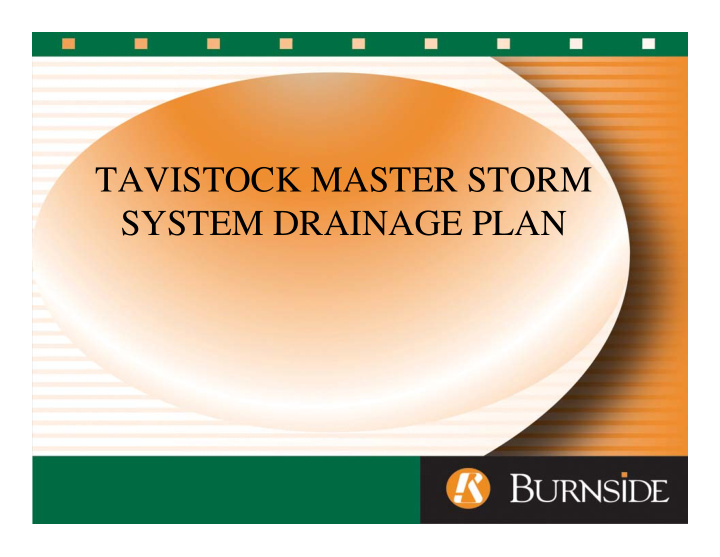



TAVISTOCK MASTER STORM SYSTEM DRAINAGE PLAN
OUTLINE • Introduction • Data Collection and Review • Existing System Characteristics • Alternative Improvement Measures • Description of the Existing Environment • Evaluation and Mitigation • Preferred Alternative • Recommendations and Implementation Strategy
INTRODUCTION • Study Purpose • Class EA Planning Process – Municipal Class Environmental Assessment (EA) – Master Plan Process • Public and Agency Consultation • Notification • Flood Prevention Working Group
Study Purpose • Review existing storm sewer system • Identify areas that are considered ‘high risk’ for flooding • Review Township standards and comment/recommend any necessary changes/strategies • Review overland flow routes and identify areas of surface restrictions and recommend improvements • Develop alternative solutions to reduce current flooding • Review the advantages of stormwater management
EXISTING SYSTEM CHARACTERISTSICS • Current Design Criteria – Private Drain Connections (PDCs) • Minor System Performance – Existing Conditions – Design Rainfall – Design Flow Rates – Runoff from External Areas – Minor System Capacity Analysis Results • Major Overland Flow Rates
Current Design Criteria • Review of current design standards - Township of East Zorra- Tavistock Municipal Servicing Standards, Urban and Rural Developments • Compare existing system to the current day design standards Design Rainfall • 1:5 year storm (current design standard for minor system) • 1:10 year storm (current design standard for trunk storm sewers)
Minor System Performance – Existing Conditions Design Flow Rates • Determined using the Rational Method and current Township Development Standards • Additional allowance of 10% added to account for PDCs and infiltration flows Runoff from External Areas • Tavistock receives overland storm runoff from areas beyond the village limits
Cont’d Minor System Performance – Existing Conditions Minor System Capacity Analysis • Each length of storm sewer pipe was considered in the analysis • While parts of the existing system does not meet the current day design standards, the system may have met or exceeded the design standards in place at the time of construction
Major Overland Flow Routes • Major overland flow routes generally follow the path of Municipal Drains that have been constructed • Flow paths have been established along the road system of the newer residential subdivisions • Sections of the overland flow routes are unable to accommodate the major design storm
ALTERNATIVE IMPROVEMENT MEASURES • Alternative 1 – Do Nothing • Alternative 2 – Storm Sewer Replacement • Alternative 3 – Policy Review and Update • Alternative 4 – Lot Level Controls • Alternative 5 – Conveyance Improvement Measures • Alternative 6 – Storage Facilities / Stormwater Management
Alternative 1 – Do Nothing • Leave the existing storm system as is • Does not meet the current study objective and flooding would not be reduced within Tavistock
Alternative 2 – Storm Sewer Replacement • Replacement of all local storm sewers unable to convey the design storm • Help alleviate some of the stresses on the storm sewer network • The storm sewer replacement alternative would not eliminate surface flooding and/or residential basement flooding
Alternative 3 – Policy Review and Update • The Township’s Development Standards are on par with other municipalities of the same size • Minor changes to the development standards will aid in reducing/preventing any flooding in future development areas
Alternative 4 – Lot Level Controls Storage Controls • Rear yard storage, Parking lot storage, Direct roof leaders to rain barrels Infiltration Controls • Direct roof leaders to rear yard ponding area or soakaway pits, infiltration trenches, and vegetated buffers along flow paths PDC Disconnection • Prevent gravity PDC, and require them to be constructed with Township Development Standards
Alterative 5 – Conveyance Improvement Measures Sewers • Trunks sized to accommodate the 1:10 year storm • Restrictor plates in catchbasins to control water entering storm system Overland Flow • More water may remain on the surface due to the restrictor plates, therefore overland flow routes must allow continuous positive drainage away from buildings and to an acceptable outlet
Alternative 6 – Storage Facilities / Stormwater Management • Effective option to help detain, store and control the outlet flow of the stormwater • Two detention facilities are anticipated to provide adequate storage capacity for external drainage coming from the north and northwest of the village
Evaluation of Criteria Natural Environment Socio-Economic/Cultural Environment •Designated Sites/Species •Public acceptance •Water Quality and Quantity •Land Requirements •Floodplain Lands •Compatibility with Surrounding Land Uses •Terrestrial Habitat •Heritage Resources •Aquatic Habitat •Effects on safety •Temporary Construction Impacts (Dust, Technical Factors Noise, Vibration, detours, loss of business) •Technical practicability •Topographic considerations Financial Factors •Reduction in flooding •Estimated Capital Costs •Effects on downstream users •Estimated Operation & Maintenance •Effects on upstream developments Costs •Approvals/Permits
PREFERRED ALTERNATIVE The preferred alterative is the combination of the following: • Policy Changes – Alternative 3 • Lot Level Controls – Alternative 4 • Conveyance – Alternative 5 • Storage – Alternative 6
Recommend
More recommend